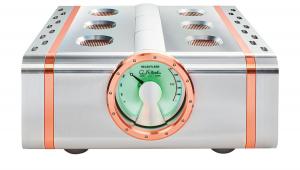EMM Labs PRE/MTRS

 Powerful, but trading subtlety and musical sensitivity over brute force, Ed Meitner’s flagship MTRS stereo power amplifier finds its perfect partner in the all-analogue PRE
Powerful, but trading subtlety and musical sensitivity over brute force, Ed Meitner’s flagship MTRS stereo power amplifier finds its perfect partner in the all-analogue PRE
The promotional literature for EMM Labs’ MTRS stereo power amplifier is so sure of its designer’s cachet within the audiophile community that it simply refers to him as Ed. For those not in the know, Ed is Ed Meitner, founder of Canada’s EMM Labs, and – back in the day – the engineer tasked by Sony and Philips to help with the development of SACD. The company that bears his initials operates in the high-end (there’s a more ‘accessible’ Meitner Audio brand) and maintains a boutique separates catalogue.
Its latest arrivals are the MTRS amplifier, yours for £65,000, and a partnering preamp, the £25,000 PRE. The last of these is a fully balanced all-analogue design, to which could be added EMM Labs’ DA2 V2 DAC and NS1 streamer for network-attached music, and the DS-EQ1 Optical Equaliser for vinyl playback via one of DS Audio’s optical pick-ups. Meanwhile, the MTRS is a hulking solid-state Class A/B amp.
Hulking is an apposite word. Like other premium power amplifiers, including the recent Relentless 800 from D’Agostino, the MTRS will not slot neatly into a hi-fi rack (it’s 544mm wide and 584mm deep) and once installed, most likely between your loudspeakers, you won’t want to move it. At 82kg it’s a two-man lift, while adding to its imposing nature is a 30A power socket, for which a hefty Kimber Kable mains lead is included.

Vow Of Silence
This amplifier is a first for EMM Labs in that it’s a two-channel design – until now its focus has been solely on monoblocks, up to the recent MTRX2 Mono (£85,000 per pair) and the older, but more powerful, MTRX Reference (£POA). It’s rated at 330W per channel, but into 4ohm, and as PM notes in his Lab Report, this figure is trumped by some (far smaller) contemporaries.
The reason for this, says Meitner, is a desire to maintain signal purity and stability. ‘Power was limited by the toroidal transformers. We had a lot of problems getting “silent” ones and were restricted by what they could do because it is very difficult to transfer the heat out’. EMM Labs’ toroidal supplier, he adds, ‘is very careful with the spec’. The MTRS’s linear PSU underpins its MOSFET output stage, while all other circuity – including a new input stage that the company says has been in development for nearly ten years – runs off a switchmode PSU, this giving rise to the amplifier’s ‘hybrid’ power supply designation.
The PRE preamp has a full-width chassis but is small in comparison to the MTRS. Both have a similar aesthetic however, with silver or black fascias split by a black soft-finished mid-section bearing the legend Meitner Design. There’s nothing else here on the power amplifier apart from a light-touch power button, almost hidden next to the EMM logo, while the PRE has a large display and a row of control buttons underneath. A word on these buttons. Using them to switch inputs or access menu options on the preamplifier is at first disconcerting, because it’s tricky to judge how hard to press – a nice ‘click’ wouldn’t hurt. Simply, you just need to touch them.

30A AC inlet is partnered with a glorious Kimber Kable 30A power cable for compatibility. Audio inputs are on RCAs and balanced XLRs with speaker cable outlets on Furutech spade/4mm binding posts
See The Light
Other elements of usability might also raise an eyebrow. For instance, the amp’s manual mentions that its down-firing status light (which can be turned off) glows red when the unit is in standby and blue for full power. In use it turns out to be purple for standby and orange for powered. Also, the PRE’s chunky Kimber Kable mains adapter almost blocks the on/off rocker switch once it’s connected.
However, in other areas there’s a welcome attention to detail. The preamp’s display can be adjusted for brightness and contrast and has settings for preset volume and balance for the trio of (re-nameable) inputs. Presets can be recalled by the A, B and C keys on the PRE’s machined aluminium IR remote. The volume display can also be changed from a dB scale (–68 to +6) to steps (0-100), and there’s a soft mute key on the handset, alongside a ‘hard’ mute.
Connections on the PRE preamp are straightforward, with balanced XLR and unbalanced RCA pairs for its inputs, plus three outputs (supporting bi- and tri-amped set-ups) split between XLR (x2) and RCA (x1). Next to these are an RS232 control terminal and USB service port. The MTRS power amp follows suit with balanced and unbalanced inputs and an RS232 socket. Speaker connection is via robust Furutech binding posts.
EMM Labs says the PRE ‘builds on the heritage’ of the mid-1990s PA6i preamp which Meitner designed for Museatex, and the company’s more recent PRE2 model, but has been ‘totally redesigned’. Its high-quality volume control is a bespoke, software-driven analogue design, feeding into a PCB made from a ceramic substrate said to combine superior thermal and dielectric properties. ‘When you add copper lines to the board, it gets to be quite a length’, says Meitner, ‘so we treat it as an interconnect’.
Another custom ceramic PCB is implemented in the MTRS power amplifier, which itself leverages tech from its mono siblings, including integrated real-time monitoring and automatic protection, a zero (overall) feedback topology, and the promise of being ‘able to handle any speaker load with ease’.


















































